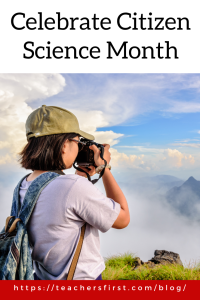Every month, the TeachersFirst Classroom Planning Calendar highlights events and observances, some of which help raise awareness of meaningful causes. A few highlights for April are Earth Day, National Poetry Month, and Financial Literacy Month. We can’t forget the shenanigans and tricks on April 1, but there’s no foolin’ that April is also Citizen Science Month, a perfect time to explore this unique branch of science.
Citizen science is science for everyone—an opportunity for people to help scientists with experiments, collecting data, analyzing results, and solving problems. Science is a discipline that continues to be one of history’s most significant collective efforts. Data and information are sometimes challenging for scientists to collect, and citizen scientists can assist with the process while building meaningful connections to science. The video below from SciStarter (reviewed here) provides an overview of citizen science.
Citizen science volunteers have helped the scientific community make considerable progress, and our students have the opportunity to participate. SciStarter’s project finder is a searchable database of citizen science projects that contain a video, directions, and links for additional resources. One example is Globe at Night, (reviewed here), an international citizen science project on the impact of light pollution. By participating, students learn about the topic and can make a red light to better view the night sky. Share the resources with your student’s families, or explore the maps and data section of the site to analyze light pollution in your location.
The Experimental Learning Blog has 20 citizen science projects with easy-to-access resources for students of all ages. CitizenScience.gov allows you to search through many projects the EPA, NASA, NOAA, the National Park Service, and many other agencies offer. Each year, bee populations are declining throughout the U.S. and Canada. Citizen Community Science for Bees (reviewed here) allows students to locate and take pictures of pollinators in their habitat using iNaturalist (reviewed here). Students share photos with more than one million scientists, researchers, and naturalists to help protect bees.
If you’re a middle-level educator, pair your students’ citizen science experiences with MySciLife. In MySciLife, students bring learning to life by using social media technology they know and like to personify science concepts, all while practicing digital citizenship skills and connecting with their peers. Your students can create an identity in MySciLife associated with your citizen science topic, then report their findings from the first-person point of view of their identity as they interact with other students. You can also explore the TeachersFirst Edge for web 2.0 tools your students can use to organize, analyze, and present information from their citizen science experiences.
April is the perfect time to explore a new citizen science project or introduce your colleagues, friends, and family to citizen science. Share your ideas and favorite resources for citizen science in the comments below!


